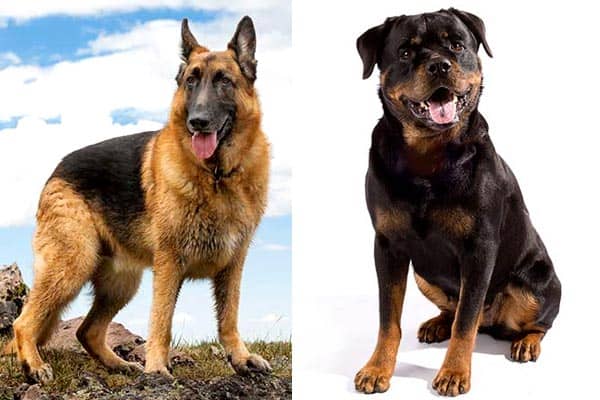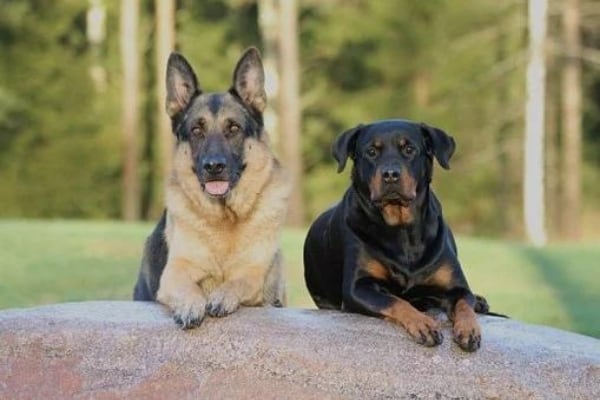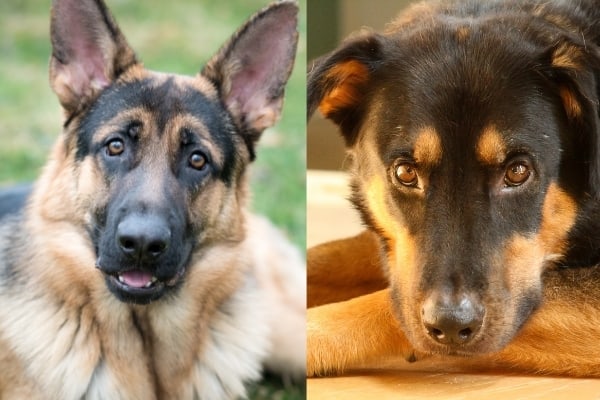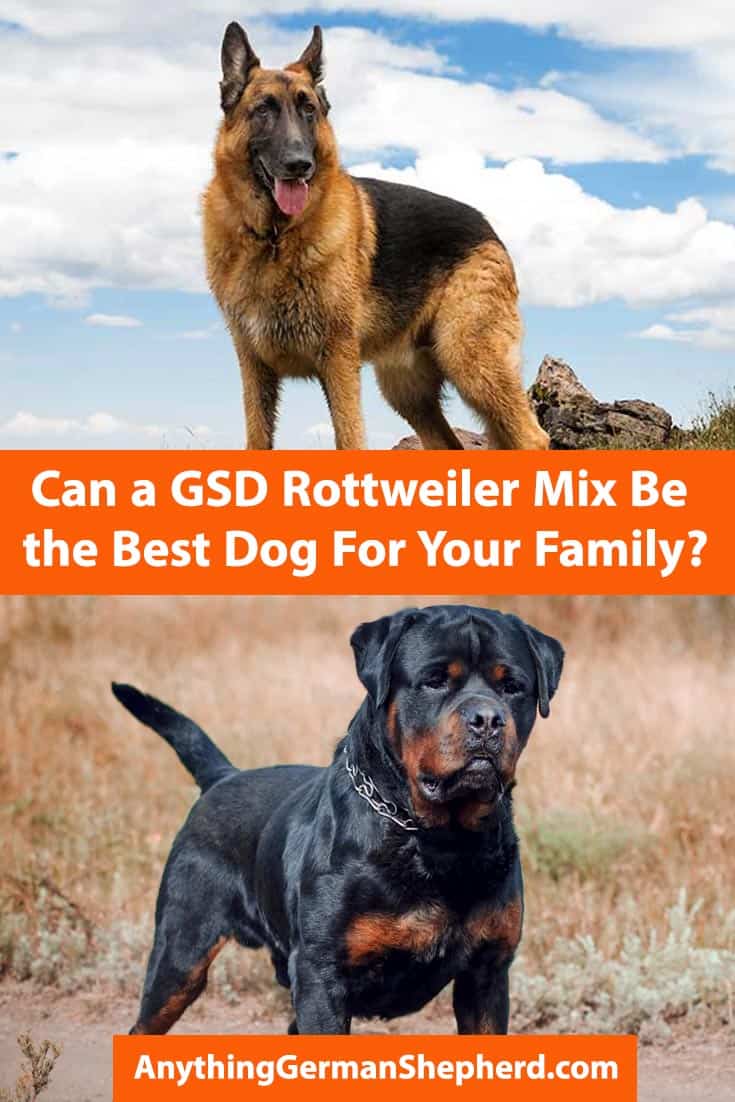German Shepherd Rottweiler Mix: Can Shepweiler Be the Best Dog For Your Family?
What do you think about when someone mentions a designer dog? Most likely you imagine a Goldendoodle or a Maltipoo. After all, they have seemingly been around forever and still define canine cuteness and charm.
What about creating a super working dog? Would a German Rottweiler mix result in such a beast? Or would he be too aggressive
A cross between a purebred German Shepherd and a Rottweiler goes by several names. In the Designer Breed Registry, it is a Rottweiler Shepherd. Other names are the Shepweiler, Rottie Shepherd, and Shottie.
The German Shepherd Rottweiler mix results in a large watchdog that makes a wonderful and versatile family companion.

It starts with two German backgrounds and a strong work ethic
Max Von Stephanitz developed the German Shepherd Dog from a herding prototype, a show dog named Hektor. He proclaimed Hektor Linksrhein the first German Shepherd in 1899 after changing the dog’s name to Horand von Grafrath.
Stephanitz founded the German Shepherd Club and established an official breed standard that same year. German Shepherds first entered the AKC in 1908 and the UK Kennel Club in 1919.
Although they originally herded sheep, Stephanitz made sure German Shepherds could serve multiple working roles. He introduced German Shepherds as potential police dogs in the 1910s, and they became a hit for their intelligence and courage.
German Shepherds have continued to perform duties on the police force as well as serve as seeing-eye dogs, search and rescue workers, and military messengers and trackers.
The Rottweiler, named after the German villa Rottweil, has strong ancestral ties with Drover dogs from the Roman Empire. Drover dogs, or mastiff-type canids likely of Asian origins, would move cattle across Europe on behalf of the Roman armies.
After the Romans fell, ranchers still used Drover dogs to bring their cattle safely to market in Rottweil. The Mastiffs bred with local dogs of various types, producing a strong and rugged canine with exceptional endurance.
The Rottweiler breed almost became extinct in the mid-1800s with the arrival of railroad cars to transport cattle. Another blow to the breed was the rising profitability of dairy cattle that did not need transporting.
Breeds that likely influenced the final Rottweiler standard besides Drover dogs were the Greater Swiss Mountain Dog, Entlebucher, Appenzeller, and Bernese Mountain Dog.
The Appenzeller and Entlebucher resemble smaller versions of the Greater Swiss Mountain dog, weighing only 75 and 60 pounds, respectively. According to the AKC, The Greater Swiss Mountain Dog can be almost 29 inches tall at the shoulder and weigh over 140 pounds.
A German standard for the Rottweiler was established in 1901. By this time, the Rottweiler, similarly to the GSD, gained favor as a police dog. Rottweilers were also used as ambulance and messenger dogs in the military in World War I.
Their value as messengers stemmed from the fact that they could form strong bonds with more than one handler.
Rottweilers have proven useful as guide dogs for the blind and perform well in search and rescue in disaster areas.
The Rottie found its place in the American Kennel Club in 1936 and the UK registry in 1936.
The Shepweiler had its own development
Designer breeds exploded in popularity beginning in the 1990s. The Shepherd-Rottweiler mix is a relatively common hybrid, probably originally bred around the early 2000s as a companion dog. People often seek to capitalize on the protectiveness of two guarding breeds.
Nobody knows much more about the Shepweiler’s origins.
Initially popular in the United States, the Shepweiler’s suitability as a family dog has led to increased global demand.
GSDs and Rottweilers have interesting working traits in common they will likely pass to any mixed offspring. Both engaged in herding activities.
German Shepherds belonged to the class of herding called tending. They guarded perimeters, preventing sheep from venturing into prohibited areas that housed valuable crops or dangerous conditions. Shepherds also guarded livestock against predators.
Rottweilers were drivers or heelers, much like Australian cattle dogs. They drove cattle herds in front of them by nipping at their heels. Like Shepherds, they guarded the cattle against predators. They also protected their charges against rustlers and thieves.
Your Shepweiler is likely to excel at several activities.
- Police and military
- Herding trials
- Shutzhund
- Agility
- Search and rescue

What will your German Shepherd Rottweiler Mix look like?
Both Rottweilers and German Shepherds are among the most recognizable breeds and the mix seems to produce standard type puppies, many litters looking the same.
German Shepherd appearance
German Shepherds should look stately and powerful at once. They are fearless, loyal, and focused.
A German Shepherd can be red and tan, black and tan, blue and tan, or solid blue, red, sable, fawn white, black, or a type of piebald (30% white) called panda.
Show lines of Shepherds have a sloping back while working lines have a more level topline. All dogs usually have moderately large upright ears and a long medium-square snout. They are longer than they are tall, ideally 10:8, and their best gait is their long, distinctive, flowing trot.
A German Shepherd is 22 to 26 inches tall at the top of the shoulders and can weigh 60 to 95 pounds.
Rottweiler standards
According to Anything Rottweiler, Rottweilers are universally black and tan. Tan markings can range from light brown to rust to mahogany and cannot account for more than 10% of the Rottie’s color.
Moreover, the brown markings are in a stereotypical pattern similar to those seen in black and tan Dobermans.
The Rottweiler should be a compact sturdy dog, not as bulky as a Mastiff but noticeably heavier than a GSD. Rottweilers are similar in height to German Shepherds, 22 to 27 inches tall at the withers. They weigh 80 to 150 pounds.
Females are lighter and somewhat shorter than males and should look feminine. A Rottweiler should be only slightly longer than she is tall, ideal proportions set at 10:9.
A massive head demonstrates ancient Mastiff influences, but the standard prefers a forehead with no wrinkles unless the Rottie is alert. Rotties have wide jaws and a slightly shortened muzzle.
Your first impression of a Rottweiler should be one of strength, confidence, and athleticism. Rottweilers have surprising energy and stamina and possess a springy efficient gait.
They have a level back and medium-sized floppy ears held slightly away from the skull. Rotties have a coarse and dense outer coat with an undercoat that varies in thickness depending on the weather.
German Shepherd Rottweiler mix
Shepweilers give the impression of a powerfully-built and capable dog.
With your hybrid, you can expect a dog that will probably be black and tan with half-prick ears. Most dogs have medium-sized ears that fold forward, but some may have pinnae oriented to the sides. A few will have upright ears more like a purebred Shepherd’s.
Your cross will also have a body a little longer than a Rottie’s but heavier than a Shepherd’s. Many have tails carried high and with a slight curve that sometimes reaches over the back.
Rarer colors are sable, blue, fawn, red and tan, merle, cream, and tan, or silver and tan. The merle is a marbling of silver and black, but these dogs often have brown points.
Your Shepweiler can be 23 to 27 inches tall and weigh 75 to 110 pounds.
What kind of guard dog will you have?
Neither the German Shepherd nor the Rottweiler was originally guarding dogs like the Doberman was. However, breeders selected for protectiveness over their herds which eventually spilled over to property and family.
Rottweilers gained a greater guarding role when cattle merchants began tying their money bags around their Rottweilers’ necks for safekeeping.
Both Shepherds and Rotties have several qualities that make them effective watchdogs, often deterrents to crime without specific training.
- Large size
- Commanding presence
- Self-assured and intimidating demeanor
- Loud, deep bark and aggressive stance
Your Shepherd Rottweiler cross will have the same qualities. She may not look quite as intimidating as a purebred. Petcarerx.com and other field experts agree that most guard dogs benefit more from obedience training than guard work.
Shepweilers have strong guarding instincts from both Shepherd and Rottweiler lines. Since the temperaments of hybrids can be unpredictable, your dog may be more aggressive or more fearful than a purebred dog. However, most Shepherd Rottweiler crosses are easy-going with a healthy suspicion of strangers.
To moderate aggressive tendencies, make sure to socialize and train your puppy at an early age. If you want a good guard dog, you need to teach your puppy discrimination. Dogs who cannot differentiate between a welcome guest and an intruder are the ones who get into trouble, labeled as dangerous animals.
You should enlist the help of a professional trainer for any guard dog education. Many behaviorists advise caution in training guard behaviors as most dogs with protective breeding do not need additional encouragement to be aggressive.
Your German Shepherd Rottweiler will be a natural watchdog, warning you of suspicious activity. Shepweilers are not dogs who bark without reason unless they develop bad habits out of boredom.

Does German Shepherd Rottweiler Mix have a good temperament?
Rottweiler disposition
The Rottweiler, like the Shepherd, is courageous and loyal. She should also be calm, confident, and alert. Rottweilers dramatically illustrate the importance of socialization and leadership on canine personality.
Repeatedly, sources like petaware.com expound Rottweilers as good-natured and gentle. However, forbes.com shares charts where Rottweilers are the second most-implicated breed in fatal dog attacks on people over the last 13 years.
Risk factors like the dog’s size, the experience level of the owner, and the degree of protectiveness emphasize the need for training and firm human leadership.
German Shepherd personality
German Shepherds also have a high rate of attacks largely motivated by fearfulness in poorly-bred families, insufficient socialization, abuse, and inappropriate training.
Shepweiler
Most sources will tell you that temperament is one of the most unpredictable hereditary traits. With mixed breeds, personality becomes even more of an unknown variable.
As seems to be the case with many hybrids, the Shepherd Rottie mix is often gentler and friendlier than either of its purebred parents. A kind, calm, and amiable demeanor, of course, presumes committed socialization and training.
Shotties can inherit fearful aggression tendencies from German Shepherd lines if a breeder uses unscrupulous practices. The same irresponsible selection of parents can also lead to unpredictable viciousness from the Rottweiler side.
Will your German Shepherd Rottweiler Mix have health issues?
Rottweilers only live about 8 to 10 years while German Shepherd can live 9 to 12 years. Both have a long list of health concerns.
Shep-Rottie mixes can inherit several of the disorders that either or both the purebred parents suffer. They live from 10 to 13 years, according to thehappypuppysite.com.
– Gastric dilatation and volvulus (GSD or Rottie) – The stomach becomes distended or bloated in GDV and is susceptible to the rotation, cutting off blood supply and dragging other organs like the spleen with it. GDV is common in large-breed dogs, especially those with a relatively deep chest.
– Elbow dysplasia (GSD or Rottie) – Elbow dysplasia is an abnormal growth process of the joint. As the elbow no longer glides together smoothly, cartilage can break off causing pain and discomfort.
It affects up to 55% of Rottweilers and as many as a fifth of German Shepherds. Your Shepherd-Rottweiler mix is quite vulnerable to elbow dysplasia.
– Hip Dysplasia – Like elbow dysplasia, hip dysplasia is a growth abnormality of the join causing incongruency. According to the OFA database, both German Shepherds and Rottweilers have an incidence of hip dysplasia around 20%.
– Degenerative myelopathy (GSD) – A progressive degenerative disease of the spinal cord, myelopathy is a devastating illness with no cure.
– Cherry eye (Rottie) – Cherry eye is an inflamed gland of the third eyelid.
– Eyelid deformities (Rottie) – The lids can either droop (ectropion) or roll inward onto the eye (entropion). Some cases are so severe they require surgical correction.
– Heart problems (Rottie) – Cardiomyopathy is heart enlargement caused by cardiac malfunctioning.
– Hypothyroidism (GSD) – A low-functioning thyroid gland can cause coat dullness and sluggishness.
– Allergies
– Panosteitis (GSD) – Panosteitis is generalized inflammation of the bones in growing large-breed puppies.
– Autoimmune disorders (GSD)
– Cancer (Rottie) – Rotties are not uncommonly victims of cancer at an early age.

Is owning a German Shepherd Rottweiler mix a liability?
More than likely you are well aware of current and proposed bans and insurance issues against particular breeds of dogs. You might wonder if certain types of legislature apply to your dog who is a mix.
Unfortunately, if a breed is on a prohibited dog list, the ban often applies to any mix that includes that type. Moreover, legislation has become clever, including language that bans any dog that even resembles the prohibited breed.
I remember when everyone would call their Pit Bull a Boxer mix and it worked. However, with current DNA tests, it is much easier to prove your dog’s breed.
Many animal experts, like the ASPCA, feel it would be more reasonable to make judgments based on an individual dog’s disposition rather than breed.
However, with the high hospital costs from dog bites and soaring litigation and intolerance of canine aggression, breed bans are not likely to go away any time soon.
Guard dogs now appear on an overwhelming number of rental property leases, and many insurance companies will turn away customers who own them. Rottweilers now star on many dangerous dog lists, and German Shepherds are becoming increasingly vulnerable to area bans.
Although most behaviorists agree that dog bites rarely cause serious injuries and almost always result from poor treatment, training, breeding, or socialization, insurance companies tend to guard against potential losses.
If you are thinking of moving, as an owner of a Shepweiler, you need to check leases, insurance policies, and homeowner association bylaws for prohibited breeds. You may have to re-evaluate your prospective living situation if Dobermans, Rottweilers, or German Shepherds are on any of those lists.
How much should your Shepweiler eat?
According to K9web.com. your Rottie mix should eat about 50 calories per pound of body weight each day. To prevent concerns with bloat, you can split your dog’s feedings into three meals a day. If you prefer a more exact measure, feed your dog 1 to 3% of his body weight daily, per Dogs Naturally Magazine.
You will need to adjust your Shepweiler’s volume based on her weight. Rottweilers are prone to obesity, so if your mix seems to be gaining too much weight, adjust the volume of food accordingly.
If your pet is extremely active and having a difficult time maintaining his mass and muscling, you may have to add more treats or feed an extra meal.
A raw diet can be a highly nutritional option for your Shepweiler with guidance about balance from a canine dietician or your veterinarian.
Nutritionists, veterinarians, and breeders differ in opinion about how much protein your dog should eat.
Loveyourdog.com says your Shepweilers requirements are 18 to 22% protein. Advocates of feeding your dog true to her wolf ancestry suggest your Shepweiler can handle a diet comprised of up to 54% protein.
When given a choice, dogs seem to prefer high-fat diets with only 38% protein. Some commercial diets approach numbers close to 35%.
The most important component of dog food is the quality of ingredients, especially the protein and fat sources. Dogs can tolerate higher protein quantities from high-quality animal-based sources.

Rottweiler Shepherds require plenty of exercises
Rottweilers require about an hour of exercise per day, while a German Shepherd needs an hour and a half to two hours. Both breeds benefit from a mixture of vigorous exercise and mental stimulation.
Mental work can take the form of interactive games or training. A strenuous workout may involve romping in the dog park or running alongside you as you take a bicycle ride.
Shepweilers require about an hour to an hour and a half of exercise daily. Like his purebred parents, the Shepweiler’s intelligence requires blending physical activities with mental exercises.
How easy are Shepweilers to train?
German Shepherds and Rottweilers both have training challenges.
German Shepherds are generally obedient but may challenge an owner who is unsure or lacks confidence. Some individuals are dominant and always challenge authority, try to take the leadership role, or react aggressively to any attempts to control them.
Rottweilers are also usually obedient but can be dominant, stubborn, or independent.
With both parents in the top 10 most intelligent dogs, according to, Shepweilers have an abundance of smarts. Rottweilers and German Shepherds also are highly trainable.
However, the condition is these German dogs are simple to handle by experienced large-dog owners. Your Shepweiler, likewise, could be a challenge to a novice because of his size and influences from two dominant breeds.
If you want to own a socially amenable Shepweiler, you must have the time to train, socialize and exercise her, the strength to handle her, and the self-assured personality to establish respect.
Shepweilers are powerful dogs with the potential to be strong-minded and dominant. Professional training can greatly benefit you and your pet.

Do German Shepherd Rottweiler mixes get along with other pets and children
You should exercise caution exposing your Shepweiler to very small children. Her size makes it easy for her to accidentally knock toddlers over, and her nature may be too rambunctious for small kids.
Moreover, ancestral background traits of herding can carry over to current generations. German Shepherds may nip and nudge to move children and Rottweilers often intentionally bump with their bodies. Either herding maneuver can be injurious to small children.
Although a well-socialized Shepweiler gets along with other dogs, keep in mind males can more aggressive than females and some dogs of either parent breed may exhibit hostility to other canids.
German Shepherds and Rottweilers have a heightened prey drive, although many learn to get along with pets with whom they share a household, even cats. Watch your Rottweiler Shepherd around small animals.
This is an example of a typical GSD Rottie mix. More than likely you have seen one or two of this type of dog.
He is large with a physique midway between a Shepherd and a Rottweiler and the common black and tan coloration.
Notice how active he is. He may wear a muzzle per liability requirements, or he may have shown aggression in the past.






























